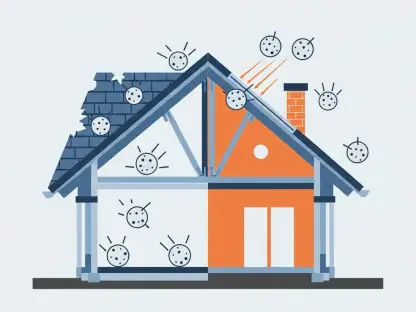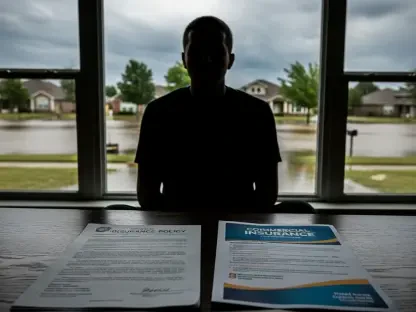The landscape of American homeownership is undergoing a dramatic transformation as homeowners insurance premiums have skyrocketed to an average of nearly $3,000 annually for single-family homes across the United States. This unprecedented surge, driven by the escalating impacts of climate change and compounded by economic pressures, is not just a financial burden but a fundamental challenge to the dream of owning a home. For current owners, the rising costs strain household budgets, while prospective buyers face significant barriers that threaten to reshape the housing market. From coastal regions battered by hurricanes to inland areas hit by severe storms, the ripple effects of these premium hikes are felt nationwide. This growing crisis demands attention as it alters how properties are valued and purchased, pushing stakeholders to seek urgent solutions to maintain affordability and accessibility in an era of increasing environmental and financial uncertainty.
Climate Change as the Driving Force
The primary catalyst behind the soaring insurance premiums is the intensifying impact of climate change, which has dramatically increased the frequency and severity of natural disasters across the country. Hurricanes ravage coastal states like Florida, wildfires devastate California’s landscapes, and floods and tornadoes strike with alarming regularity in inland regions. Insurers, faced with mounting claims and unpredictable risks, have had to overhaul their risk assessment models, resulting in a reported 24% average increase in premiums over the past three years. In some high-risk areas, the jumps are even more staggering, with rates spiking by as much as 40% within a single year. This shift reflects a harsh reality for homeowners who find themselves bearing the brunt of environmental changes beyond their control, as insurance companies pass on the costs of heightened exposure to catastrophic events, reshaping the financial landscape of property ownership in vulnerable zones.
Beyond the immediate impact of natural disasters, climate change is creating a long-term recalibration of how insurers operate in the marketplace. The unpredictability of weather patterns has made traditional risk models obsolete, forcing companies to adopt more conservative pricing strategies to safeguard their bottom lines. This approach, while necessary for the industry’s sustainability, places an outsized burden on homeowners, particularly in states where extreme weather events are becoming the norm rather than the exception. The result is a growing divide between regions deemed insurable and those increasingly seen as high-risk, where coverage is either prohibitively expensive or outright unavailable. As climate-driven events continue to escalate, the pressure on insurance providers to adjust premiums upward shows no sign of abating, leaving many to question how long the current system can hold before systemic changes are forced upon the industry and its consumers.
Financial Impact on Homeowners and Buyers
The financial toll of rising insurance premiums is profoundly altering the calculus of homeownership for both current owners and aspiring buyers. Surveys reveal that 75% of recent and prospective homebuyers express deep concern over whether these escalating costs will render owning a home unaffordable, often leading to delayed purchases or a shift toward properties in less vulnerable areas. This apprehension is particularly acute in a housing market already hampered by high mortgage rates and limited inventory, where additional costs like insurance can tip the scales against a sale. In regions prone to natural disasters, the hesitation among buyers is palpable, with many walking away from deals when the numbers reveal unsustainable long-term expenses, further slowing an already sluggish market and creating a bottleneck of unsold properties.
Equally concerning is the strain on existing homeowners, who must contend with premium increases that often outpace inflation and wage growth. For many, these costs are not just an inconvenience but a genuine threat to financial stability, forcing tough decisions about whether to maintain coverage, reduce it to bare minimums, or even relocate to more affordable areas. The disparity is stark in high-risk zones, where the combination of rising rates and limited insurer options leaves residents with little room to maneuver. This financial pressure is reshaping community demographics as middle-income families, once the backbone of suburban and rural homeownership, find themselves priced out of markets they have long called home. The broader implication is a housing sector increasingly stratified by risk and affordability, where the ability to own a property hinges as much on insurance costs as on traditional factors like income or creditworthiness.
Economic Pressures Beyond Climate Risks
While climate change is a significant driver, economic factors are also fueling the steep rise in insurance premiums, creating a perfect storm of challenges for homeowners. Reinsurance costs, which insurers rely on to mitigate their own risks, have surged in recent years due to global demand and the increasing unpredictability of catastrophic events. Coupled with labor shortages in the construction industry, the price of post-disaster repairs has skyrocketed, pushing insurers to raise rates to cover these inflated expenses. This economic ripple effect means that even homeowners in relatively low-risk areas are not immune to premium hikes, as the broader cost structure of the insurance industry adjusts to a new reality of higher operational expenses and thinner margins for providers.
Adding to the complexity, many major insurance carriers are reducing their exposure by withdrawing from high-risk markets altogether, leaving homeowners with fewer options and often unaffordable quotes. Data indicates that nearly half of home shoppers last year encountered significant barriers, such as outright coverage denials or premiums that exceeded their budgets. This shrinking availability exacerbates the affordability crisis, as competition among remaining providers diminishes, allowing those still in the market to set rates with little downward pressure. The result is a fragmented insurance landscape where access to coverage is increasingly determined by geography and risk profile, rather than a universal standard of protection. As economic constraints tighten, the gap between insured and uninsured properties widens, posing risks not just to individual owners but to the stability of entire communities in disaster-prone regions.
Responses and Strategies for Adaptation
In the face of these mounting challenges, various stakeholders are scrambling to adapt through innovative strategies and policy responses. Homebuyers are exploring alternative insurance options, such as smaller regional providers or specialized policies, while some negotiate with sellers for credits to offset the burden of high premiums. Real estate agents, recognizing the pivotal role of insurance in today’s market, are advising clients to prioritize long-term cost projections during due diligence, ensuring that buyers are fully aware of potential rate increases over time. These individual-level adaptations reflect a growing awareness that insurance is no longer a secondary consideration but a critical factor in the feasibility of homeownership, particularly in areas susceptible to environmental hazards.
On a broader scale, policymakers and industry leaders are attempting to address the crisis through systemic measures, though results remain mixed. State-backed risk pools, implemented in places like Florida, aim to stabilize premiums by spreading costs across a wider base, but critics argue that such initiatives are insufficient to tackle the scale of the problem. Meanwhile, discussions on social media platforms reveal a rising interest among property owners and investors in unconventional approaches, such as self-insuring or maintaining substantial emergency funds to cover potential losses. These grassroots ideas, while not universally viable, highlight the desperation felt by many who see traditional insurance models failing to meet their needs. As the debate over solutions continues, it is clear that a combination of individual ingenuity and coordinated policy reform will be necessary to navigate the evolving challenges of insuring homes in an increasingly risky world.
Looking Ahead to Sustainable Solutions
The future of homeowners insurance appears daunting unless significant interventions are enacted to curb the trajectory of rising costs. Experts project that without federal subsidies or advancements in resilient building standards, premiums could continue to outstrip inflation, potentially leading to a 10-15% suppression of home sales in vulnerable regions over the coming years. State-specific disparities are particularly alarming, with areas like Texas bracing for some of the steepest increases due to frequent storm activity. The housing market, already under strain, risks further stagnation as buyers prioritize insurance affordability alongside traditional metrics like location and price, fundamentally altering how real estate transactions are approached in high-risk zones.
Despite the grim outlook, glimmers of hope emerge through innovative proposals that could reshape the insurance landscape. Concepts like parametric insurance, which disburses payouts based on predefined event triggers rather than assessed damages, are gaining traction as a potential way to streamline claims and reduce costs for both insurers and homeowners. Additionally, calls for enhanced building codes and community-level disaster mitigation efforts aim to lower overall risk, potentially easing the pressure on premiums in the long term. As these ideas take root, the path forward hinges on collaboration between government, industry, and consumers to reimagine a system where homeownership remains attainable. Reflecting on the strides made in past policy debates, the focus now shifts to actionable reforms that prioritize sustainability and equity, ensuring that the lessons of yesterday inform the protections of tomorrow.









